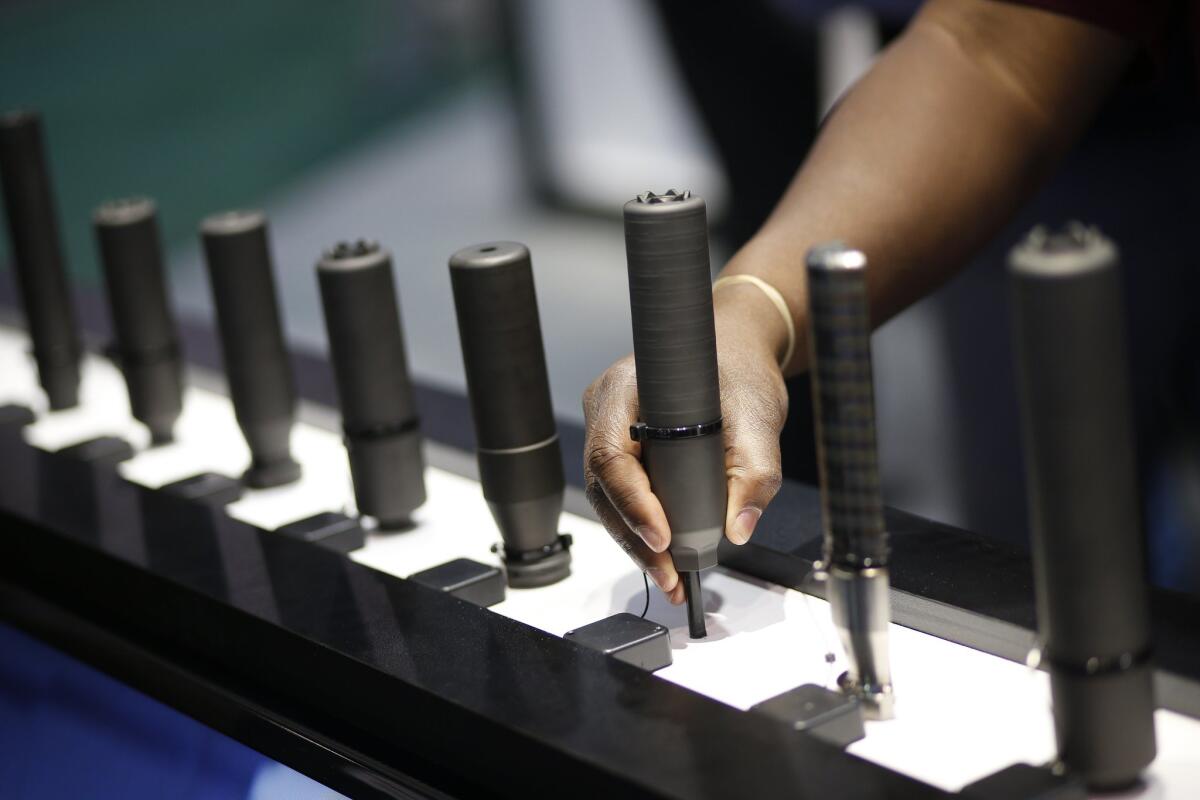Op-Ed: Gun silencers are useful, not scary

Silencers are on display at the Sig Sauer booth at the Shooting, Hunting and Outdoor Trade Show, held on Jan. 19 in Las Vegas.
- Share via
More than 100 years ago, inventor Hiram Percy Maxim created two almost identical products to accomplish the same goal in two very different industries. The divergent ways we treat those products today reveals the irrationality driving our national firearms debate.
One of Maxim’s inventions, a muffler for the internal combustion gasoline engine, was lauded for its ability to reduce ear-splitting noise. Now mufflers are mandatory for cars, trucks, buses, and industrial machinery to keep people from suffering permanent hearing loss.
Even “silenced,” the most common rifles and pistols are as loud as a rock concert.
Maxim also invented a gun muffler. Popular among hunters and target shooters worldwide, even President Theodore Roosevelt was an avid supporter of the so-called Maxim Silencer. Silencers were in common use in the United States until the Great Depression, when impoverished Americans began using silenced rifles to poach deer, rabbit, and other animals — sometimes even livestock — to feed their families. This did not sit well with game wardens, ranchers or the federal government.
When Congress passed the National Firearms Act in 1934 to regulate machine guns, sawed-off shotguns and short-barreled rifles favored by Prohibition-era gangsters, silencers were thrown in for good measure. If a person wanted to buy a silencer, he had to seek approval from the federal government and then buy a punitively expensive tax stamp. (That’s still true today.) Gun mufflers have largely been associated with crime ever since, thanks to the Hollywood cliche of an assassin ominously screwing a silencer onto the barrel of a gun before a fight he almost always loses.
In the movies and on television, silencers reduce the sound of gunfire from a loud and distinct bark to a faint cough that can’t even be heard from the next room. In the real world, the three sounds created when a gun fires — the supersonic crack of the bullet, the muzzle blast of gasses created by burning gunpowder, and the cycling of the weapon — simply cannot be completely eliminated.
The end result is that a “silenced” gun shot still sounds like a gun shot, but roughly 30 decibels lower. That’s about as much of a noise reduction as you would expect from wearing earmuffs or sticking your fingers in your ears. Even “silenced,” the most common rifles and pistols are quite loud.
Gun silencers, to those with no actual firearms experience, seem scary — they seem criminal. Hoplophobes cannot conceive of why a law-abiding person would want to own one. But for the millions of Americans who understand that guns, like cars, are tools, silencer regulation is a nonsensical nuisance. We use mufflers on engines to spare drivers’ ears on the road; why shouldn’t we use mufflers on guns to spare shooters’ ears at the firing range?
Even with good noise-canceling equipment, several hours of shooting still exposes the shooter to a racket that can cause a temporary ringing in the ears and long term hearing loss. By using both silencers and earplugs, frequent shooters can not only help their own hearing, but cut down on environmental noise as well.
Infrequent shooters also benefit from silencers. Firing a gun indoors in self-defense, for instance, can temporarily deafen a homeowner with a single shot, and any subsequent shots compound the problem. This could lead to a nightmare scenario in which a traumatized homeowner can’t hear law enforcement officers responding to a 911 call, or orders to put their hands up.
There are now more than 800,000 silencers in the hands of citizens who are refining and defining their role in American society.
We now know that silencers make precision rifles more accurate, shotguns easier to swing on a consistent arc after clay pigeons and training guns much less intimidating for new shooters.
And at last there is a strong national push to remove silencers from the National Firearms Act via the Hearing Protection Act in the U.S. House of Representatives. The bill has 50 co-sponsors, and would remove the $200 tax and six to nine month delays that typically accompany suppressor approval from the Bureau of Alcohol, Tobacco and Firearms.
Under the revised law, anyone wishing to buy a silencer to protect their hearing would still be required to fill out an ATF form at their gun dealer, and would still undergo a background check.
Second Amendment restrictionists often say they want “common sense gun safety” measures, but more often than not their proposals are neither common sensical, nor about safety. Making silencers readily available to protect hearing, on the other hand, is a supremely logical way to defend shooters and bystanders from harm.
Bob Owens is the editor of BearingArms.com, a firearms educator and a frequent radio and television commentator about Second Amendment issues.
Follow the Opinion section on Twitter @latimesopinion and Facebook
More to Read
A cure for the common opinion
Get thought-provoking perspectives with our weekly newsletter.
You may occasionally receive promotional content from the Los Angeles Times.










